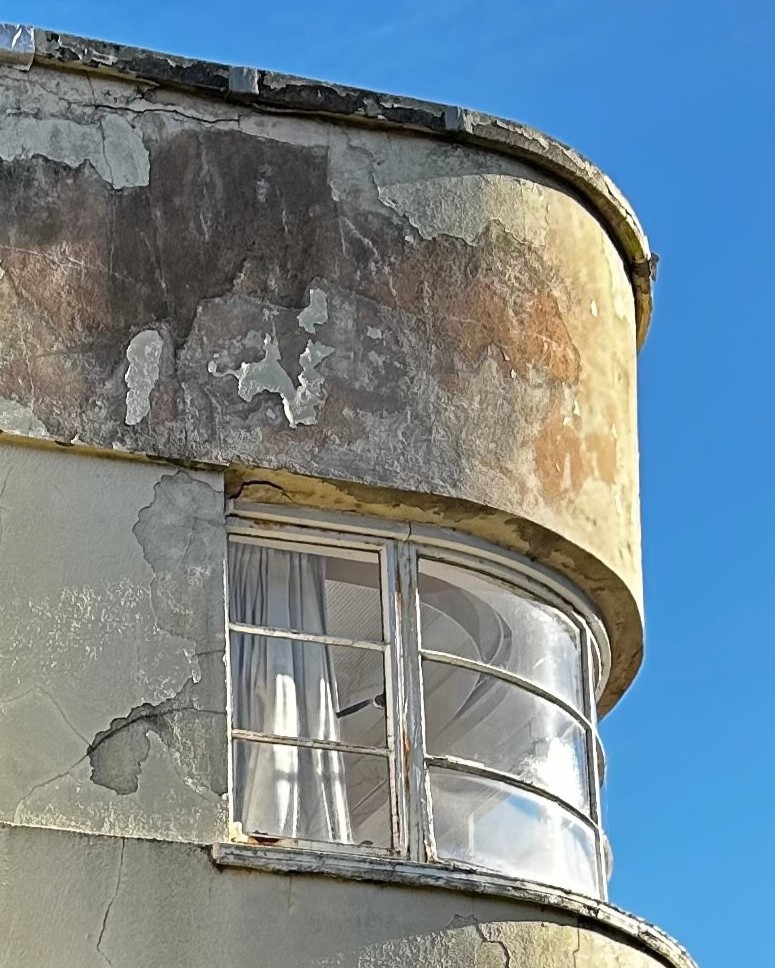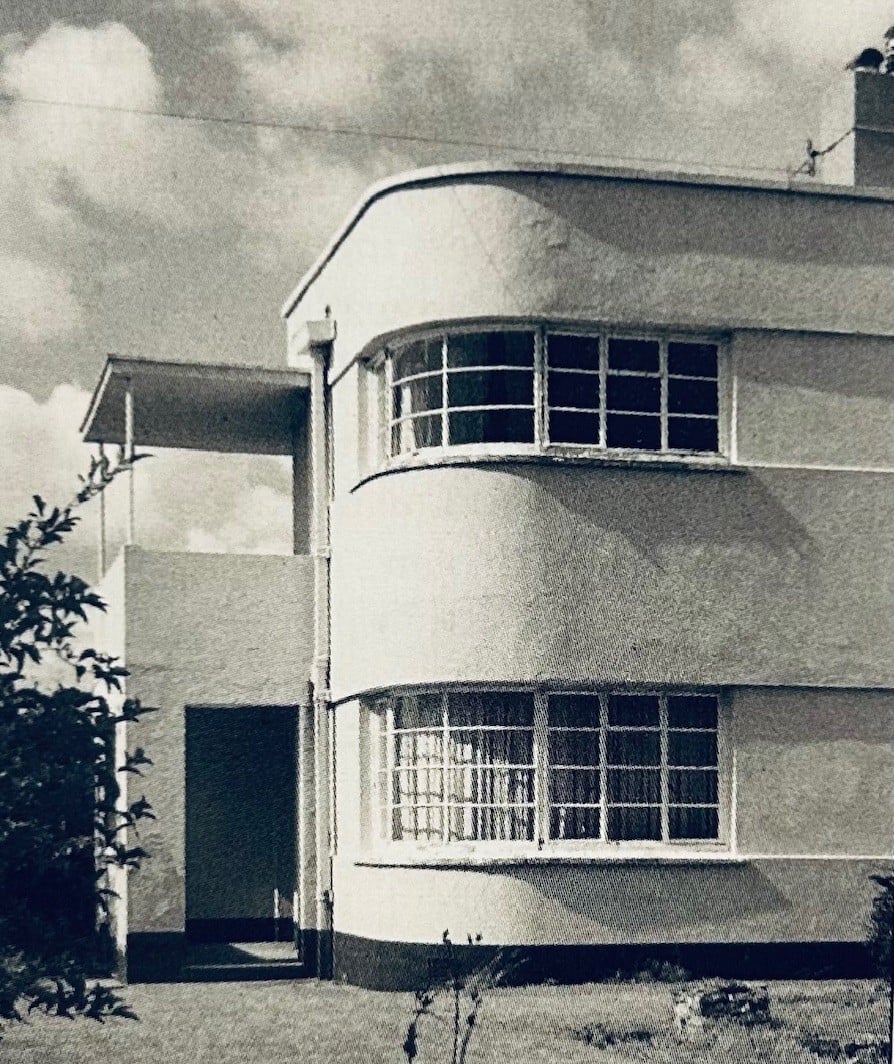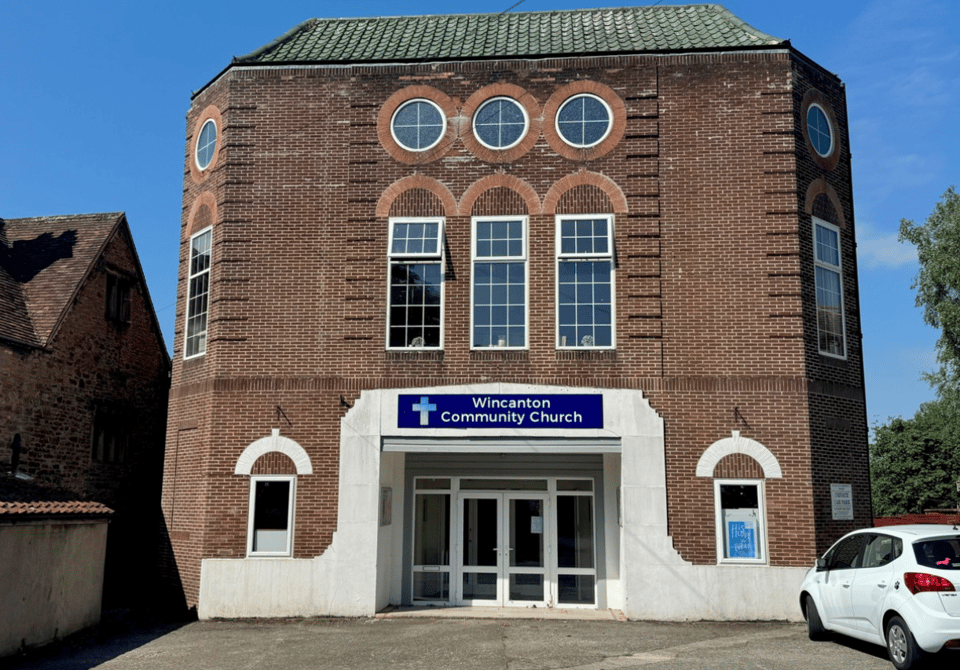Field Notes: 26 February 2025
Finding a 1930s gem falling into decay, plus a round up of events and news related to west country modernism.
Hello! I’m moving to a Wednesday publication day instead of Fridays.
The end of the week is a habit, due to having run several newsletters that published on Fridays in various public sector jobs. But I do not need to be constrained by such habits! So here’s a midweek hit of modernism. This week covers:
A house I’ve long wondered about
Some 1960s pubs
Events that might be of interest
A news round up that includes some bats in a wartime observation post.
The house behind the trees
There’s a modern housing estate, out on the Exeter to Exmouth railway line, that has been built on the site of an old US Navy supply base. Until the 1980s the huge derelict stores and Quanset huts, built for D-Day, dominated the view from the train apart from a glimpse of pale render in one corner. As the stores came down and the housing went up, the glimpse of render remained.
I kept meaning to find out more. At the start of this February I had time to kill before a meeting nearby, so I walked up Old Rydon Lane to see if I could reach the house.
I did.

The render is breaking off and the metal frames of the windows are rusting away. There’s a giant septic tank in one corner of the drive. A sunken pond area in the lawn instantly reminded me of the Blue Peter garden. I only took a couple of photos, and only from the drive, as the house is occupied.
Getting home, I checked the slim 2001 Discovering Exeter 11: Twentieth Century Architecture booklet by Eduardo Hoyos-Saavedra and found it. The VITACOP House (1936) was designed by R M Challice and Son, a local architect firm that also created the staggeringly lovely Zenith House (1933). Hoyos-Saavedra calls VITACOP House “probably the purest and most remarkable example of modern architecture in the city” but warned it was in a state of decay. His photo of the house in 2000 looks beautiful compared to its current state.

I’m hoping to dig into this more, to see why the house is slowly dying. And if there is a case for it being listed, even if just locally, so that grants can be unlocked to restore it.
Take courage
Just outside our area, Boak and Bailey have been to an exhibition in Bristol about pubs. More precisely, about the Courage brewery’s 1960s construction spree. Their write up includes a lovely photo of the Devon Yeoman in Whipton, Exeter. I’m heading up that way soon, so may see how it looks now.

Courage’s 1960s modernist pub building frenzy | Boak & Bailey
Courage built a lot of new pubs in the period after World War II, as documented in a volume held at Bristol’s central library.
Events
On 4 March, the University of Plymouth is hosting a talk by Professor Matthew Kelly about Dartmoor with the pleasing title of Rural Subtopia. Dartmoor became a national park in 1951, changing how it was - and is - perceived. Unsurprisingly, this created a tension between the romantic ideals and the practical use of the moors.

Rural Subtopia? Regulating Dartmoor in the 1950s and 1960s Tickets, Tue, Mar 4, 2025 at 7:00 PM | Eventbrite
Opportunities and conflicts in the early years of the national park, presented by Professor Matthew Kelly, Northumbria University.
The Seaside Heritage Network (SHN) is hosting a free webinar on 26 March about British Seaside Resorts as world heritage sites. This will be far broader than the west country. Find out more and book a place on the SHN website.
The Devon in the 1920s festival kicks off in March, starting a season of exhibitions and events looking at life in the county. It ranges from the building of Lutyens’ Castle Drogo - the first twentieth century building the National Trust acquired - to the urgent need for suitable housing after world war 1. Explore the programme of events here.
Local news of C20th buildings
In which I fight my way through local ad-laden news sites to find stories about twentieth century buildings.
Bruce Wayne, auf weidersehn

Fort Henry is a Grade II listed observation bunker in Dorset from which Churchill and Eisenhower observed D-Day rehearsals. It’s also a bat cave. The bats like the concrete apparently. No idea if Sir Winston did. The NT and Dorset Bat Group are working to keep the bats safe. (Source: BBC News)
Saturday night at the movies
The 1934 Plaza Cinema building in South Street, Wincanton, Somerset is set to reopen. It’s been a cinema, a bingo hall, a cinema and a church. Originally designed by Edward G. De Wilde Holding, who designed twelve cinemas around the west country according to Cinema Treasures. You can take a peak inside on the estate agent’s listing though it is now sold subject to contract (Source: The Somerset Leveller.)

If you know of an event or news item you think I should know about, you can contact me on Bluesky, or use WestCM[at]MagsLHalliday.co.uk to email me.
If you’re liking my field notes and deep dives, you can support the work with a paid subscription. Just £3 a month will get you early access to the deep dives and a warm fuzzy feeling from covering my costs.
The deep dive on Totnes’ Civic Hall will be out to paying subscribers next week. I’m off to take extra photos of it tomorrow.